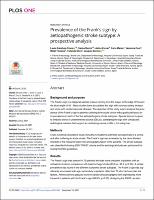| dc.contributor | Departament de Salut |
| dc.contributor.author | Sánchez-Cirera, Laura |
| dc.contributor.author | Bashir, Saima |
| dc.contributor.author | Ciscar, Adina |
| dc.contributor.author | Marco, Carla |
| dc.contributor.author | Cruz, Verónica |
| dc.contributor.author | Silva, Yolanda |
| dc.contributor.author | Serena, Joaquín |
| dc.contributor.author | Terceño, Mikel |
| dc.date.accessioned | 2022-02-07T13:55:04Z |
| dc.date.available | 2022-02-07T13:55:04Z |
| dc.date.issued | 2021-12-15 |
| dc.identifier.citation | Sánchez-Cirera L, Bashir S, Ciscar A, Marco C, Cruz V, Terceño M, et al. Prevalence of the Frank's sign by aetiopathogenic stroke subtype: A prospective analysis. PLoS One. 2021 Dec 15;16(12):e0261080. |
| dc.identifier.issn | 1932-6203 |
| dc.identifier.uri | https://hdl.handle.net/11351/6987 |
| dc.description | Cerebrovascular disorders; Ear auricle |
| dc.description.abstract | Background and purpose: The Frank's sign is a diagonal earlobe crease running from the tragus to the edge of the auricle at an angle of 45°. Many studies have associated this sign with coronary artery disease and some with cerebrovascular disease. The objective of this study was to analyse the prevalence of the Frank's sign in patients suffering from acute stroke with a particular focus on its prevalence in each of the five aetiopathogenic stroke subtypes. Special interest is given to embolic stroke of undetermined source (ESUS), correlating the sign with clinical and radiological markers that support an underlying causal profile in this subgroup.
Methods: Cross-sectional descriptive study including 124 patients admitted consecutively to a stroke unit after suffering an acute stroke. The Frank's sign was evaluated by the same blinded member of the research team from photographs taken of the patients. The stroke subtype was classified following SSS-TOAST criteria and the aetiological study was performed following the ESO guidelines.
Results: The Frank's sign was present in 75 patients and was more prevalent in patients with an ischaemic stroke in comparison with haemorrhagic stroke (63.9 vs. 37.5, p<0.05). A similar prevalence was found in the different ischaemic stroke subtypes. The Frank's sign was significantly associated with age, particularly in patients older than 70 who had vascular risk factors. Atherosclerotic plaques found in carotid ultrasonography were significantly more frequent in patients with the Frank's sign (63.6%, p<0.05). Analysing the ESUS, we also found an association with age and a higher prevalence of the Frank's sign in patients with vascular risk factors and a tendency to a high prevalence of atherosclerosis markers.
Conclusion: The Frank's sign is prevalent in all aetiopathogenic ischaemic stroke subtypes, including ESUS, where it could be helpful in suspecting the underlying cardioembolic or atherothrombotic origin and guiding the investigation of atherosclerosis in patients with ESUS and the Frank's sign. |
| dc.language.iso | eng |
| dc.publisher | Public Library of Science |
| dc.relation.ispartofseries | PLoS One;16(12) |
| dc.rights | Attribution 4.0 International |
| dc.rights.uri | http://creativecommons.org/licenses/by/4.0/ |
| dc.source | Scientia |
| dc.subject | Malalties cerebrovasculars |
| dc.subject | Orelles - Malalties - Patogènesi |
| dc.subject.mesh | Cerebrovascular Disorders |
| dc.subject.mesh | Ear Auricle |
| dc.subject.mesh | /pathology |
| dc.title | Prevalence of the Frank's sign by aetiopathogenic stroke subtype: A prospective analysis |
| dc.type | info:eu-repo/semantics/article |
| dc.identifier.doi | 10.1371/journal.pone.0261080 |
| dc.subject.decs | accidente cerebrovascular |
| dc.subject.decs | pabellón auricular |
| dc.subject.decs | /patología |
| dc.relation.publishversion | https://doi.org/10.1371/journal.pone.0261080 |
| dc.type.version | info:eu-repo/semantics/publishedVersion |
| dc.audience | Professionals |
| dc.contributor.organismes | Institut Català de la Salut |
| dc.contributor.authoraffiliation | [Sánchez-Cirera L] Fellow of Neurology, Stroke Unit, Departament de Neurologia, Hospital Universitari de Girona Dr. Josep Trueta, Institut Català de la Salut (ICS), Girona, Spain. [Bashir S, Marco C, Terceño M, Silva Y] Neurologist, Stroke Unit, Departament de Neurologia, Hospital Universitari de Girona Dr. Josep Trueta, Institut Català de la Salut (ICS), Girona, Spain. Institut d'Investigació Biomèdica de Girona Dr. Josep Trueta (IDIBGI), Girona, Spain. [Ciscar A] Student of Medicine, Medicine Faculty, University of Girona, Girona, Spain. [Cruz V] Nurse of Neurology, Stroke Unit, Departament de Neurologia, Hospital Universitari de Girona Dr. Josep Trueta, Institut Català de la Salut (ICS), Girona, Spain. [Serena J] Departament de Neurologia, Hospital Universitari de Girona Doctor Josep Trueta, Institut Català de la Salut (ICS), Girona, Spain. Institut d'Investigació Biomèdica de Girona Dr. Josep Trueta (IDIBGI), Girona, Spain |
| dc.identifier.pmid | 34910754 |
| dc.rights.accessrights | info:eu-repo/semantics/openAccess |

